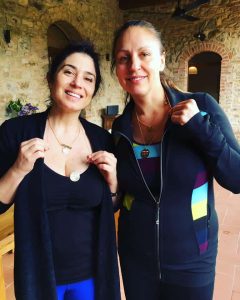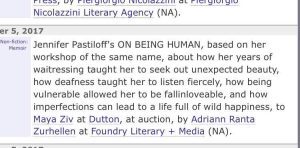By Elizabeth Fournier
As long as I can remember, I was always dancing around the house. Mom and I were fans of Donny & Marie, so I always got up and danced when they came on TV. My mother would be lying on the couch because she was always sick, but my dancing would make her smile. I danced my heart out for her.
One time, I shook, shook, shook my booty and Mom’s smile disappeared for a moment.
“Good girls don’t do that,” she warned.
What! It seemed so natural to move my butt when I was dancing. Why not? I tried not to do that move any more, but it was hard.
My formal dance training in tap, jazz, and ballet started at age four. Dance class was super fun because I had a natural talent for it. When the music started, most of the girls hung back, uncertain. Not me; I pushed to the front, eager to perform. Having practiced all week, I could execute every move with confidence.
After Mom died, I danced for anyone I could press into watching. Our garage was the scene of many an elaborate performance. I always hoped to be discovered, so up went the garage doors on Saturday, Captain & Tennille blasting, and goofy me dancing for the people and dogs passing by.
Whenever I danced, I imagined my mother watching and smiling at me from some celestial balcony. Surely, she would be proud of me if I became a Solid Gold dancer, right? I studied their choreography carefully, trying to decide whether or not they kept their butts within the good girl boundaries. If I was going to be damned, I would at least be damned on the Solid Gold center stage. So worth it, and Mom would understand.
Despite my dreams of glittery fame, I had such a strong preoccupation with death. I scoured National Geographic articles about death rituals in other cultures. Pyres seemed interesting: imagine going up in a dramatic wall of flame! That’s an attention getter.
Once I could drive, I went to funerals of people I didn’t know—like in Harold and Maude. First, I went to a nearby mortuary, but eventually I branched out across Portland’s metropolitan area. Saturdays often found me lurking around a back pew dressed in black. I knew all the classic dirges by heart and sometimes found myself unguardedly humming “Blessed Assurance” or “Just a Closer Walk with Thee.” The Protestants really have it going on when it comes to funeral hymns.
Other people’s funerals were comforting, to a degree, but often left me dissatisfied. Obviously, I am fond of processions, but compared to some of the customs I had read about, the generic American funeral seemed sterile. Detached even; the body in a box wearing Sunday-go-to-meetin’ clothes. Service was recited, eulogy delivered, and then we walked past the casket off to the church annex for ham sandwiches and deviled eggs. Where were the age-old rituals that prepared the bodies of the recently deceased for their journey to the afterlife? I missed keening or lamentations. We were just expected to sit there politely and passively while the professionals handled it. It wasn’t working for me.
It’s not that people weren’t grieving. You could see the desolation of the nearest and dearest, the sadness of close friends, and discomfort of coworkers. They hurt, plainly, but they were lost and at loose ends and there was no solace for them. It was like watching Big Bird learn Mr. Hooper had died. Not fair; they deserved something better than that. I wanted to provide a better emotional setting/ritual for mourners but, at my young age, didn’t quite know how to do this. Maybe get up and say something thought-provoking about the decedent? About the beauty in the circle of life and death?
I left one stranger’s service stewing over these thoughts and failed to make my escape before being noticed. My escape through the vestibule was interrupted by a tiny, ancient woman in a shiny black suit.
“How did you know Magda, sweetie?” she asked.
“Uh, from the church?” Actually true, I had met Magda at the church just an hour ago. She was the lady lying in the coffin, after all!
“That’s nice you came,” my gentle interrogator said, patting my arm.
“You’re a good girl.”
I blinked hard to keep from crying, nodded and fled. After that, I spent less time at the funerals of strangers; but as graduation approached, I began talking about a career in funerary services.
Teased my brother: “I thought you were going to be a Solid Gold dancer? I guess now we have to support your new fantasy to be the ersatz ferrywoman for those crossing over the River Styx, Morticia.”
Weeks later, I landed my job as a live-in cemetery night keeper. To celebrate, I stopped by a wacky gift shop on my way home and bought a card with a picture of Morticia Addams on it. I wrote “Congratulate me!” inside—no signature—and dropped it in the mail to my brother. A few days later, the florist delivered a large bouquet of roses from Nick.
Attached to the ribbon that encircled the vase was a pair of scissors, so I could snip off their heads.
Elizabeth Fournier operates a one-woman funeral service in the rural town of Boring, Oregon. Elizabeth supports the philosophy of old school burial practices that are kinder to both humans and the Earth. She has humbly been baptized the “Green Reaper” for her passionate advocacy of green burial, and as an undertaker always ready to lend a hand, or a shovel as the owner and undertaker of Cornerstone Funeral Services, the first green funeral home in the Portland Metropolitan area. You can preorder her forthcoming book here.


